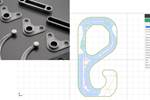Anisoprint, Additive Flow launch full-scale topology optimization software for composites
Additive Flow’s FormFlow software enables users to optimize geometry smoothly through all phases of the design process. The tool is compatible with Anisoprint’s slicing software, Aura, for composite 3D printing.
Anisoprint (Esch-sur-Alzette, Luxembourg), a composite 3D printing startup, and (London, U.K), a British additive manufacturing (AM) software developer, now offer a full-scale computer-aided engineering (CAE) tool compatible with Anisoprint’s slicing software, , for composite 3D printing. The software will reportedly enable users to optimize geometry smoothly through all phases of the design process. The beta version will be released in October 2021.
Continuous composite 3D printing requires extensive expertise to design anisotropic structures, specifically for fiber paths, load simulation patterns, thermal exposure calculations, weight and other tasks. According to the companies, such tasks can only be performed by professionals with structural performance of materials expertise.
Additive Flow’s software, Formflow, is a CAE tool for performance analysis and structural anisotropic design. Additive Flow says Formflow will boost the advantages of Anisoprinting. Developing designs with anisotropic structures is now automated and precise, and prototyping will be faster with assistance from AI-driven computation and optimization. The trial-and-error method will now be replaced by physics simulating algorithms that define optimally performing parts. Material use will also be optimized.
According to Additive Flow, FormFlow takes care of topology, decreasing the manual input involved in printing and enabling specialists to focus on other work. In addition, the software leads to improved flexibility due to clear quantitative analysis of loads.
Formflow is now designed to export files compatible with the Aura proprietary slicer. Users are not required to know the geometry of the model, only the target parameters. Thermal resistance, strength, stiffness, weight, sustainability, time and cost of production can be mapped in Formflow to calculate the optimal shapes and properties. Once the model is optimized, it is fed to Aura to prepare for printing.
Related Content
-
The next evolution in AFP
Automated fiber placement develops into more compact, flexible, modular and digitized systems with multi-material and process capabilities.
-
The potential for thermoplastic composite nacelles
Collins Aerospace draws on global team, decades of experience to demonstrate large, curved AFP and welded structures for the next generation of aircraft.
-
Industrializing additive manufacturing in the defense/aerospace sector
GA-ASI demonstrates a path forward for the use of additive technologies for composite tooling, flight-qualified parts.






